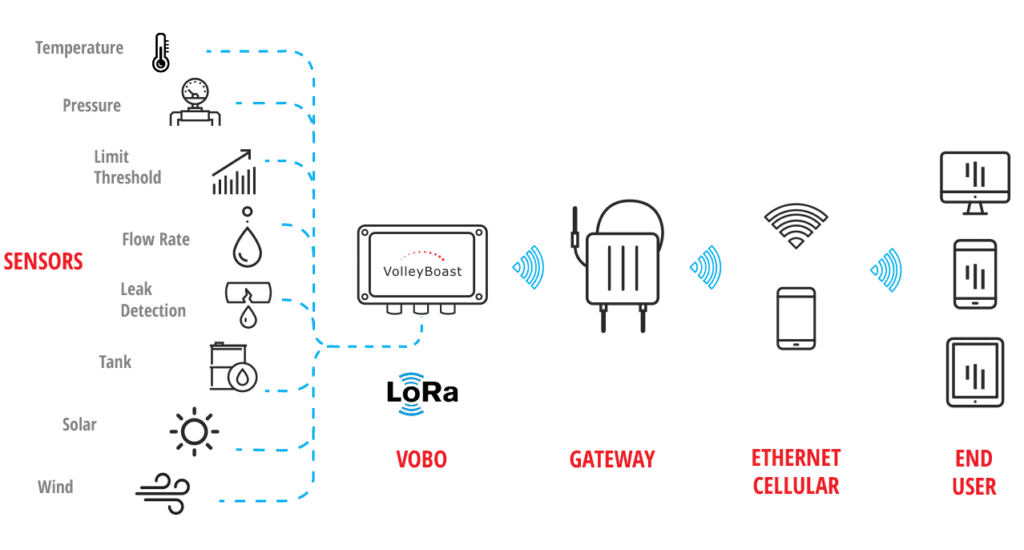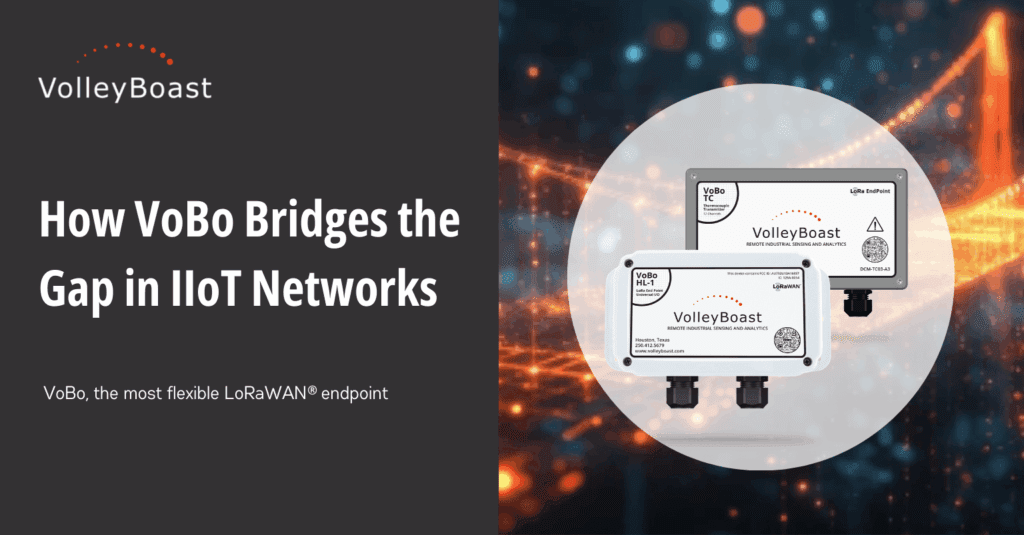LoRaWAN® networks provide long-range, low-power communication for Industrial IoT (IIoT) applications. What happens when legacy, unconnected, or remote sensor data needs to be connected to the IIoT network? VoBo solves this problem by bridging the gap between wired sensors and IIoT networks.
LoRaWAN® Network Architecture
Let’s take a look at a common LoRaWAN® architecture. This will help us understand the gap that can exist between devices and networks.
1. Sensors and Transmitters – These are sensors that collect data at the edge of the network. They typically produce an output signal through a wired connection. They’re often placed in hazardous industrial locations where it can be difficult and costly to connect to a network.
2. End devices – These are devices, also called endpoints, that collect data and transmit that data to LoRaWAN® gateways.
3. Gateways – These are the devices that receive data from the end devices and forward it to the network server. The gateways can be near the end devices or a few miles away.
4. Network server – This server manages the LoRaWAN® network and routes the data to the application server. The application server processes the application-specific data received from the gateway and routes it to the end user application. The end user application uses the data collected by the LoRaWAN® network.
As you can see, there are several steps to get the data from the sensors at the edge to the end user. But there is often a gap between the sensor and end devices.
The Gap in the LoRaWAN® Network
In a LoRaWAN® network, an end device, or endpoint, transmits data to a gateway. This forms the foundation of the data collection network. The data collected at the edge is usually from sensors that measure properties such as pressure, temperature, flow, etc.
There are many sensors that measure physical properties and parameters, but most endpoints are limited in their connectivity to those sensors and even more limited in hazardous environments. This often requires companies to replace legacy sensors or build a wired infrastructure, which can be costly.
VoBo Bridges the Gap
A VoBo solves this by creating a bridge between the sensor and the gateway, bridging the gap between wired sensors and a LoRaWAN® network. It connects to, and can power under certain circumstances, wired sensors and transmit data wirelessly over long distances to a LoRaWAN® network.
Industry standard and legacy instrumentation are now available to use with LoRaWAN®.
VoBo Connects to Multiple Sensor Types

The Vobo is sensor-agnostic and provides multiple analog, discrete, and serial inputs, allowing it to communicate with a wide variety of sensors.
The VoBo GP-1 and HL-1 in standard configuration can accept multiple analog, digital, and serial input channels. The VoBo TC has 12 thermocouple input channels.
VoBo input signal types include:
- 4-20mA Analog sensors – The VoBo GP-1 and HL-1Up can read up to three 4-20mA sensors.
- 0-5V and 0-10V Analog sensors – The VoBo GP-1 and HL-1 can read up to three voltage output sensors.
- Discrete (digital) switches – The VoBo GP-1 and HL-1 can read up to three dry contact or voltage switches or relays (including solid state relays).
- Modbus® RTU serial devices – The VoBo GP-1 and HL-1 have one RS-485 serial input, which can read 16-bit registers from one or more Modbus® RTU devices.
- Thermocouple sensors – The VoBo TC was designed for thermocouple sensors and can read up to 12 thermocouples.
- Other sensors via interface – The VoBo can connect with many other less common sensor outputs through signal converters, which produce an output that the VoBo can read.
These sensor options make VoBo the ideal LoRaWAN® endpoint bridge.
How VoBo Creates New Possibilities
The LoRaWAN® network can be used to collect data from sensors that would be left unconnected due to cost or difficulty.
- The network can now use virtually any sensor, including legacy sensors.
- One VoBo can connect to multiple sensors at once.
- Many sensors can be powered by the VoBo, simplifying installation.
- New wiring is not needed to scale the IoT network.
There are many more benefits of using VoBo and LoRaWAN®. For more information, see the article Benefits of VoBo LoRaWAN® Bridge Endpoints.
Conclusion
Normally, a LoRaWAN® network is limited in the types of sensors it can use. VoBo solves this by acting as a bridge, connecting legacy sensors, expanding functionality, and bringing connectivity to difficult locations. The VoBo’s ability to integrate multiple sensor types, extend the wireless network reach, and ensure data reliability makes it an essential device for LoRaWAN® networks.
For more information, visit the VoBoAnalytics page or contact info@volleyboast.com.

